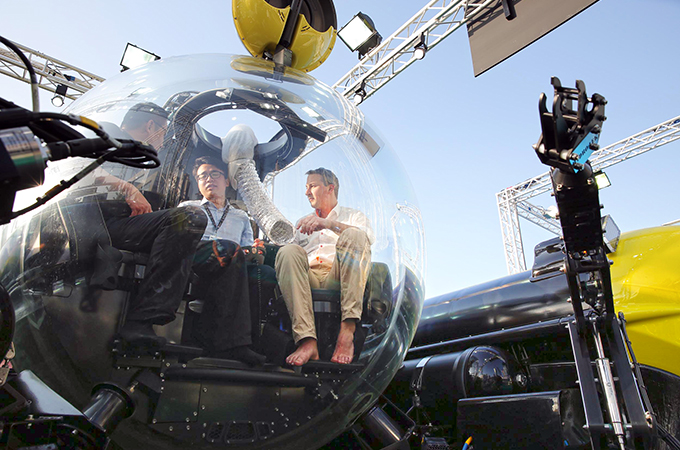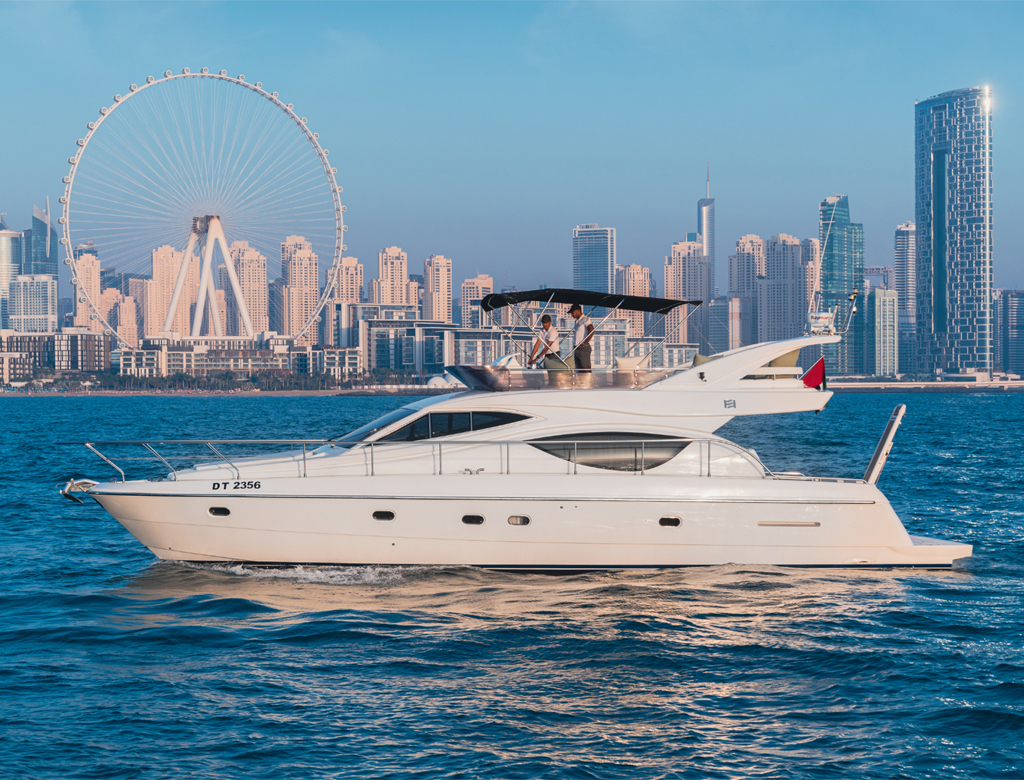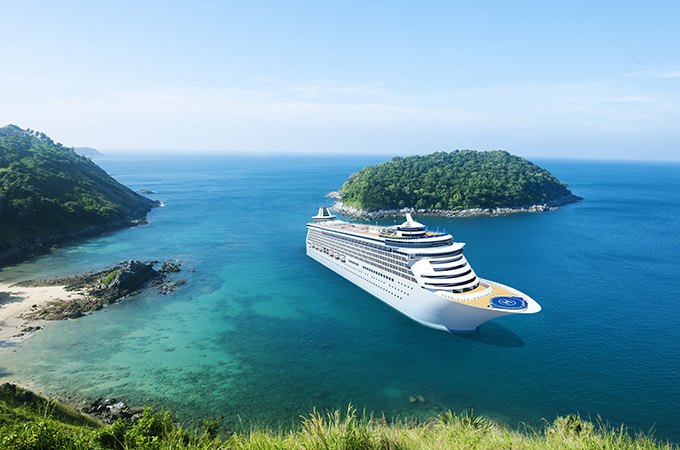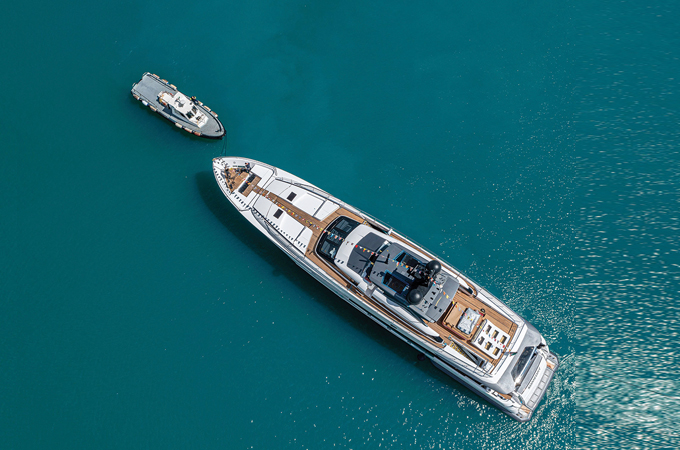Mon, Mar 7, 2016
Superyacht builders are pushing the boundaries of yacht design as buyers seek yachts that make them feel ever closer to sea.
Dutch builder Feadship, which exhibited at last week’s Dubai International Boat Show in the UAE, showcased a magnificent scale model of a yacht the company sees as a landmark achievement – the Savannah, launched last year.
Go below the waterline on most yachts and all you will see is the inside of a hull. The Savannah, by comparison, offers something startlingly different – an ocean gallery.
“This is the first yacht to have an ocean gallery,” said Feadship Marketing and Brand Director Farouk Nefzi, describing a viewing area where a vast, underwater picture window looks out onto the sea-life swimming around the ship, and the pool is designed to share the view. “With this, the whole sea is your aquarium.”
The Savannah and its underwater gallery made big news in the yachting world when Feadship launched the ship, but it represents a trend every superyacht builder recognises: a growing number of customers want a yacht that will let them truly experience the sea.
Another Dutch superyacht builder Oceanco unveiled a model of the stunning 90-m Moonstone at the show, with a distinctive faceted hull design that aims to create a visual link between the ship, the sky and the sea – impressive to onlookers. Impressive for those on board is the vast deck area at the rear of the yacht, kept as low possible to the water. This kind of sea level space is now a regular request from customers, combined with an increased emphasis on lifestyle, and it has reshaped the way yachts are configured.
“People want to get closer the elements,” explained Michele Flandin, Marketing Manager at Oceanco. “We used to have gyms and spas on the upper deck, but we don’t have that anymore. Everything has to be at sea level. Our clients also want more and more space for wellness; on the last yacht we delivered, we had 350 sq m for a wellness and spa area.”
At Mondomarine, the new SF40 design, which had its on-water Middle East debut at the show, presented a unique challenge: to meet a demand for a better view of the water from the main living areas, while also meeting a cultural demand for family privacy in the Middle East market.
The solution was to place the owner’s area on the highest level of the living area, below the wheelhouse, with vast picture windows looking out onto private balcony areas, and superstructure carefully shaped so the owner’s deck at the front could not be overlooked by anyone outside the family.
“People insist the boat should have a great view outside,” said Roberto Zambrini, CEO of Mondomarine. “You feel you are in the open air on this boat, because you have the two balconies, and if you open the window on the balcony you are immediately in the sun, yet there is a high level of privacy and the owner’s cabin and deck cannot be seen by any guests or the crew.”
For the ultimate open air experience, Ferretti Group’s Riva Florida 88 takes things to a new level. Resembling a classic speedboat – with its sleek lines scaled up into a 26-m superyacht – the Florida 88 features a car-like convertible hard-top. With the roof in place, the upper deck forms an enclosed lounge and wheelhouse, but when the sun is shining, two hydraulic arms can lift the roof, swing it forward, and stow it on top of the forward cabin.
“You have this completely open space to enjoy,” said Gregor Stinner, CEO of Ferretti Group’s Middle East distributor, Art Marine. “And we can genuinely say this is a unique feature, because Ferretti owns the patent so nobody else can copy the design.”
DEEP THRILLS
Meanwhile, among the many water craft at this year’s show, two stood apart –not for their speed or grace across the water, but how deep they can go below the waves.
The U-Boat Worx C-Explorer 3 and Friday Personal Submarine are compact passenger-carrying submersibles that open up a new world in underwater exploration. With a maximum dive depth of 300 m, they can go 16 times deeper than the 18-m limit for the most widely held recreational diving qualification, the PADI Open Water Certificate.
“There are lots of things to explore that are too deep for scuba diving,” said Roy de Boer from U-Boat Worx. “Most shipwrecks that you can dive have been prepared, and lots of divers have already been there. With a sub, you can find shipwrecks that have never been seen since the day they sank – you can be the first there.”
Each of the two submarines owes its design to marine research equipment – and in the case of the Friday, is a spin-off from the University of Coimbra in Portugal – and is engineered to the same safety standards. Pilot and passengers sit inside an acrylic globe, offering an almost unrestricted view of the surrounding space. Propulsion is via electric motors, while the controls are similar to those used for remote aerial drones – simple to use and can be mastered with a short training course. Accessories, such as articulated arms, can be attached.
“We developed the submarine to use in our own research, aiming to dive up to 300 metres with a mission of eight hours duration,” said Fernando Seabra Santos, Friday CEO and a professor at the university. “It was an intellectual challenge for a group of researchers, and aims to be the smallest, lightest, and also the most affordable of its kind.”
The submarines’ origins are in serious research and exploration, but both cater to a growing recreational market. With maximum dimensions of around 2.5 m by 1.84 m, the Friday Personal Submarine is small enough to fit in a “regular yacht garage”, while U-Boat Worx offers a range of models to suit recreational, scientific and commercial applications, including submersibles specifically designed to be launched from yachts, and nine-passenger submarines catering to cruise ships.
Personal submarines are among a growing market for high-tech products that find new ways of experiencing the sea.
The Dive Middle East Exhibition (DMEX) at the show featured a range of tech that caters to the boom in underwater video and photography, including every GoPro accessory you can imagine, including drone miniature submarines – great for capturing underwater action, adding a new dimension to scuba diving and snorkelling. One of the ROV manufacturers at the show, Deep Trekker displayed a fish-finding underwater drone equipped with sonar.
Electric watercraft are a growing trend in boating, from hybrid superyachts to simple pleasure boats, such as the Eco Boat, powered by a solar panel-equipped canopy with battery back-up. The boat is designed for sheltered waterways, and is ideal for exploring natural wetlands without disturbing the environment.
Another product, the Quadrafoil 2QA, showed an innovative take on the personal watercraft market. Powered by a 3.7 kW electric outboard motor, the two-seat craft resembles a jet ski, with the addition of retractable hydrofoils at each corner. As the Quadrafoil accelerates towards 11 kmph, the hydrofoils lift the hull out of the water, reducing drag and allowing a top speed of around 40 kmph.
“The ride is incredibly smooth,” explained Mohamed Alshaibani, CEO of X Marine, the Middle East distributor. “The Quadrafoil lifts out of the water the moment it starts taking off, and will cruise comfortably even above when there is a bit of swell.”
The Dubai International Boat Show was held from March 1 to 5 at the Dubai International Marine Club in Min Seyahi.













.jpg)
.jpg)


.jpg)






